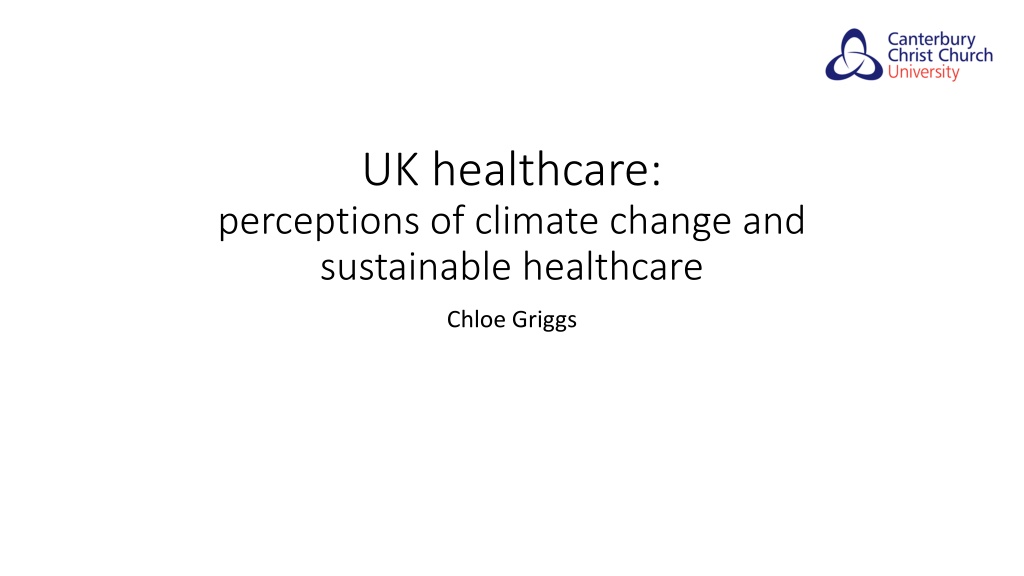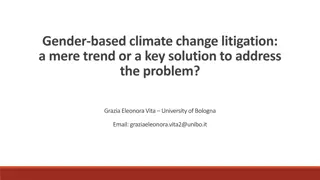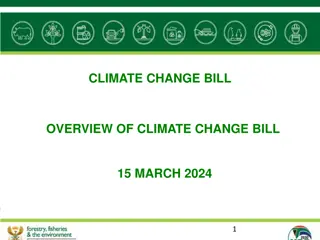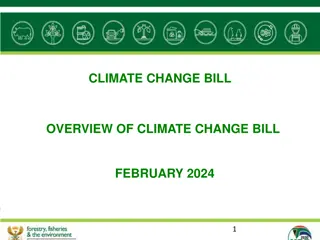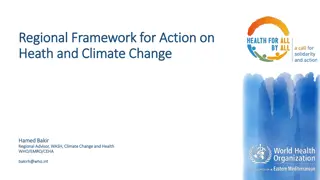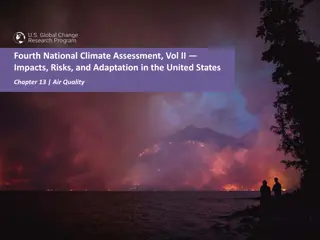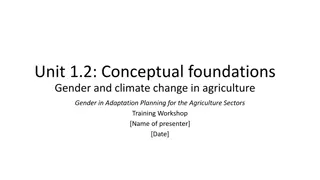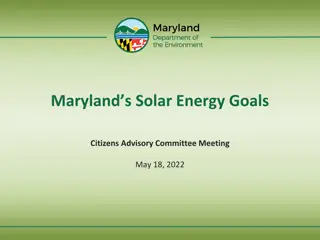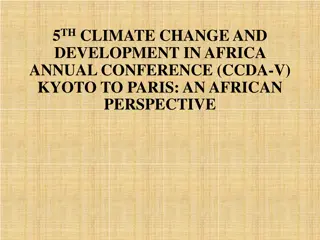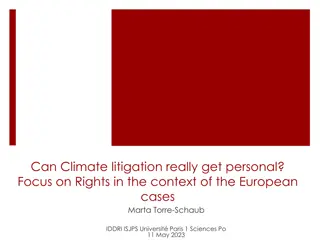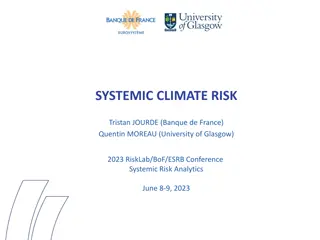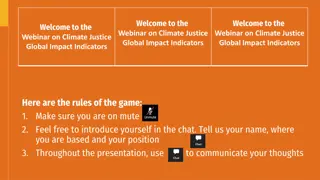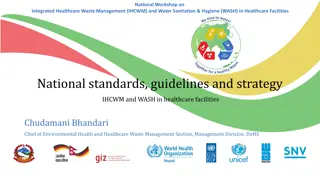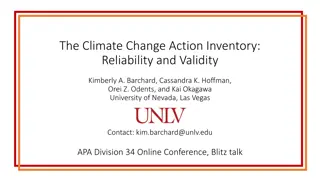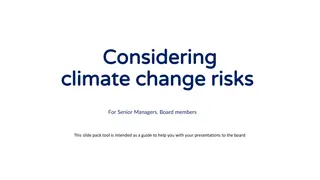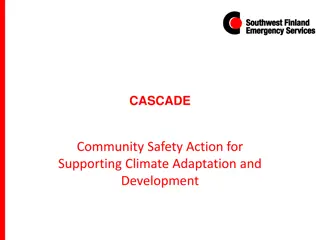Perceptions of Climate Change in UK Healthcare
The study examines the impact of climate change on sustainable healthcare within the UK context. It delves into global and local perspectives, highlighting the challenges and opportunities for healthcare professionals to engage in mitigating climate change effects. Through a literature review, the barriers to engagement are explored, paving the way for an inductive-deductive research design to understand nurses' perceptions and involvement in sustainable healthcare practices.
Download Presentation

Please find below an Image/Link to download the presentation.
The content on the website is provided AS IS for your information and personal use only. It may not be sold, licensed, or shared on other websites without obtaining consent from the author.If you encounter any issues during the download, it is possible that the publisher has removed the file from their server.
You are allowed to download the files provided on this website for personal or commercial use, subject to the condition that they are used lawfully. All files are the property of their respective owners.
The content on the website is provided AS IS for your information and personal use only. It may not be sold, licensed, or shared on other websites without obtaining consent from the author.
E N D
Presentation Transcript
UK healthcare: perceptions of climate change and sustainable healthcare Chloe Griggs
Global Context The rise in global temperature around the time of the industrial revolution suggests a strong correlation between human activity and changes to the Earth s atmosphere and this is known today as Anthropogenic Global Warming (AGW) (Intergovernmental Panel on Climate Change, 2016). Global temperatures have risen by 0.2 degrees Celsius per decade since the start of the industrial revolution resulting in a complex chain of events: increased average air temperature (due to Greenhouse Effect); acid oceans (IPCC, 2014); increased extreme weather events (heatwave / draught / flooding); rising sea levels (Albert et al., 2016) due to melting glaciers/ice fields (McMillan et al., 2014) At the current rate of carbon dioxide emission Watts et al. (2015) predict that by 2100 global temperatures will rise anywhere between 2.6 to 4.8 degrees Celsius. The World Health Organisation (WHO, 2015) predict that up to 250 000 additional deaths will be associated with global warming between 2030 and 2050.
Local Context NHS: 22.8 million tonnes of CO2 per year; 1.3 million staff; 314 966 nurses in practice in 2015; 8% of the UK s Gross Domestic Product (GDP) (SDU, 2015). Despite the carbon reduction in the NHS it continues to contribute significantly to overall UK emissions and paradoxically it is contributing to ill health as a result. Health issues in the UK: poor air quality leading to respiratory problems; increased vector born diseases (Health Protection Agency, 2015); death due to heatwaves (Public Health England, 2015); death/injury due to flooding; poor mental health due to loss of livelihood / displacement / crop failure etc (Stanke, Murray, Aml t, Nurse and Williams, 2012); poor air quality due to ground level ozone (Jerrett, Burnett and Pope, 2009). It is likely that without extreme mitigation there will be pervasive and irreversible effects of global warming on humans and ecosystems. It is recognised that nurses are in a strong position to influence sustainable practice yet there is little empirical research which explores what nurses think about climate change and healthcare associated AGW.
Literature Review Focused on the barriers to engagement. Highlighted complex psychological barriers to lack of engagement / inaction: Moral Disengagement (Bandura, 2007); Cognitive dissonance (Festinger, 1957); Bystander Effect (Latan and Darley, 1969); Denial (Cohen, 2001); Selective Disengagement (Bandura et al., 1996); Social identity theory (nursing image) (Tajfel and Turner s, 1986); Fear of derogation (weird / hippy) (Lorenzoni et al. 2007); Moral offset (Charlesworth et al. 2012); Tragedy of the Commons (Hardin, 1968). Only 11 papers globally exploring nurses and their perceptions of climate change and sustainable healthcare!
Exploratory Sequential Design INDUCTIVE Follow-Up Interpretation Phase 1 Exploratory Test findings of Literature Review Explore perceptions Phase 2 Exploratory Healthcare staff who are engaged in sustainable healthcare Connect phase 1 and 2 Emergent theory Informs next stage Qualitative Mixed Method DEDUCTIVE ITERATIVE PROCESS (CRESWELL AND CLARK, 2011)
Phase 1 Research Aim: Titles (N=15) Communications Manager Head of Patient Safety Treasurer Health Visitor Community Midwife Operating Department Practitioner Nurse / Senior Nurse / RGN Ward Matron Public Health Nurse Specialist Consultant Anaesthetist Years in Healthcare (N=15) <5 6-10 11-15 16-20 20> Setting (N=15) Private Public Charitable Age (N=15) 21-30 31-40 41-50 51-60 1 1 1 1 1 1 6 1 1 1 2 (13.4%) 4 (26.6%) 6 (40%) 3 (20%) 1. Explore perceptions of nurses and front-line healthcare clinicians, managers and estates / infrastructure staff towards AGW and environmental sustainability within the UK. 2. To explore if the themes from the literature review (Griggs et al., 2017), were present in a small sample of UK healthcare staff. 15 qualitative questionnaires: National sample via Twitter. Subject to Thematic Analysis. Nurse Band (N=11) Band 5 Band 6 Band 7 Band 8+ 3 (20%) 1 (6.7%) 3 (20%) 3 (20%) 5 (33.3%) 3 (20%) 11 (73.3%) 1 (6.7%) 2 (18.2%) 3 (27.3%) 4 (36.3%) 2 (18.2%) Geographical Region (N=15) North East East of England London South West South East 2 (13.4%) 1 (6.7%) 1 (6.7%) 2 (13.4%) 9 (59.8%)
Aims / Findings To explore if the themes from the literature review (Griggs, Fernandez and Callanan, 2017), were present in a small sample of UK healthcare staff. Yes almost all themes were evident within the sample. Confirmatory exercise. Explore perceptions of nurses and front-line healthcare clinicians, managers and estates / infrastructure staff towards AGW and environmental sustainability within the UK. New insights: emerging evidence of a much more positive and willing group of morally engaged individuals who seemed to be concerned with climate change but unable to act. This led to the exploration of different value orientations in relation to environmentally significant behaviour .
Value Types Egoist: Self-gratification, self-enhancement, comfort, lifestyle, power, wealth, hedonism, egocentric. Morally disengaged = climate change denial / avoidance. Altruist: Caring, concerned with social conformity and tradition, peace keepers, equality, social justice, anthropocentric. Morally engaged with climate change but unable to act = Attitude / behaviour gap. Biospherist: Self-transcendence, benevolence, universalism, care for the environment, sense of duty and responsibility, willing to make sacrifices, live as an example, ecocentric. Climate change activists = morally engaged Maiteny (2002), de Groot and Steg (2008), Schwartz et al. (2012)
What were they saying? I have taken on an unofficial role within my department to be a Sustainability lead. I believe this is my role, due to it being my passion.. so whatever is done is done through choice, not instruction. I believe ALL practitioners SHOULD have an ingrained role to being a sustainable practitioner. I felt like I was on my own and every time I brought up sustainability, I sensed people were almost laughing at me and thinking I was just being silly. I don t feel I have any influence but I would like to do more if the opportunities were there . A lot of people are very proud of their efforts at home but then don t do as much at work. Yes [I talk about climate change] but I m in a minority and I m very careful not to evangelise because that will turn people off . I have stopped using the most environmentally damaging anaesthetic agent in favour of an alternative technique.
Altruists May represent a significant proportion of UK healthcare staff. Strong links to suggest that altruistic people are drawn to the caring professions. Tapping into this group may have significant consequences but we still do not know enough about them . But what do I need to find out? Motivation? What would compel these individuals to act? What permission is needed? Who are they looking to for direction / instruction? What are the contextual / enabling factors?
Phase 2: The next steps. The second phase of the exploratory sequential design will be a large scale quantitative online survey. Partnering with Sussex Community Foundation Trust who run a successful staff engagement programme called Dare to Care . Inviting all staff within the organisation to take part. The aim is to explore the factors that led to staff either engaging with the programme or choosing not to engage.
Value-belief-norm (VBN) theory of environmentalism The survey will be structured using Stern s (2000) value belief norms (VBN) theory of environmentalism. Stern (2000) suggests that behaviour as an outcome is influenced by a number of variables: values, beliefs and norms.
Values The first variable is the participants value type, this will be assessed by the Modified Universal Values Scale (Schwartz, 2010) and will provide indication of whether an individual has Egoistic, Altruistic or Biospheric value tendencies. Stern, Dietz & Kalof (1993) identified these three value types more than 20 years ago, since that time they have consistently applied their theory in a range of research settings and have found consistent empirical support (Stern, Dietz, Kalof, & Guagnano, 1995; Dietz, Stern & Guagnano, 1998; Stern 2000).
Beliefs The second variable is associated with the participants beliefs and establishes their environmental world-view using the New Ecological Paradigm (NEP) scale (Dunlap, van Liere, Mertig & Jones, 2000). The NEP has been validated within a wide range of environmental research settings (de Groot & Steg, 2008; Stern, Dietz & Guagano, 1995), highlighting its use and validity in assessing ecological worldview. Beliefs around awareness of consequences and ascription of responsibility, along with personal norms will be surveyed using 21 items developed by Steg, Dreijerink and Abrahamse (2005).
Norms Personal norms and specifically motivation will be further explored using Villacorta, Koestner and Lekes s (2003) modified version of the Motivation Towards the Environment Scale (MTES) originally created by Pelletier, Tuson, Green-Demers, Noels and Beaton (1998). The MTES has been validated in a wide variety of cultural and geographical regions (Aitken, Pelletier & Baxter, 2016; Boeve-de Pauw & Van Petegem, 2017) and provides a useful instrument to measure motivation based on Deci and Ryan s (2002) self-determination theory.
Behaviour Finally, behaviour will be measured using Markle s (2013) Pro- environmental Behaviour Scale (PEBS). Validated by Prati, Albanesi & Pietrantoni (2015) this tool offers simple categories related to conservation, environmental citizenship, food and transportation.
Hypotheses: 1. 2. environmentalism, awareness of consequences, ascription of responsibility and a sense of obligation. 3. Increased environmentalism, awareness of consequences, ascription of responsibility and a sense of obligation will predict greater pro-environmental behaviour. 4. Environmentalism, awareness of consequences, ascription of responsibility and a sense of obligation will mediate the relationship between value type and pro-environmental behaviour. Value type will predict degree of pro-environmental behaviour. A biospheric value type will be associated with increased
Research Design Questionnaire research will be used to gather data from staff within SCFT. The total population size within SCFT is around 4750, therefore the sample is 356 (95% confidence level). Bristol online survey will be used to gather data. Mediation analysis will be used to explore the relationship that values (X) have on behaviour (Y) and the influence of mediating factors such as ecological worldview (M1), awareness of consequences (M2), ascription of responsibility (M3) and personal norms (M4).
Challenges Benefits Staff engagement. Climate change turns people off! Offering an attractive incentive that is also morally and ethically in line with the project. Raises staff awareness. Provides valuable intelligence on an under researched area. Could be used as a model for other organisations. Thank you for listening Any questions?
References Albert, S., Leon, X, J., Grinham, A, R., Church, J, A., Gibbes, B, A., Woodroffe, C. (2016) Interactions between sea-level rise and wave exposure on reef island dynamics in the Solomon Islands. Environmental Research Letters. 11, 1-9. DOI:10.1088/1748- 9326/11/5/054011. Bandura, A. Barbaraneli, C. Vittorio Caprara, G. Pastorelli, C. (1996) Mechanisms of Moral Disengagement in the Exercise of Moral Agency. Journal of Personality and Social Psychology. 71(2):364-374. Bandura, A. (2007) Impeding ecological sustainability through selective moral disengagement. International Journal of Innovation and Sustainable Development. 2 (1):8-35. Charlesworth, K. Ray, S. Head, F. Pencheon, D. (2012) Developing an environmentally sustainable NHS: outcomes of implementing an education intervention on sustainable health care with UK public health registrars. NSW Public Health Bulletin. 23(1- 2):27-30. Cohen, S. (2001) States of Denial: knowing about atrocities and suffering. Cambridge: Polity Press. De Groot, J. I., Steg, L. (2008). Value Orientations to Explain Beliefs Related to Environmental Significant Behavior: How to Measure Egoistic, Altruistic, and Biospheric Value Orientations. Environment and Behavior, 40, 3, 330-354. doi: 10.1177/0013916506297831 Hardin, G. (1968) The Tragedy of the Commons. Science, New Series, 162, 3859. 1243-1248. DOI: http://www.jstor.org/stable/1724745 HPA (2015) Health Effects of Climate Change in the UK 2012: Current evidence, recommendations and research gaps. Available from: https://www.gov.uk/government/publications/climate-change-health-effects-in-the-uk (Accessed: 18.11.16). IPCC (2014) Climate Change 2014 Synthesis Report Summary for Policymakers [online]. Available from: http://www.ipcc.ch/index.htm (Accessed: 30.05.16). IPCC (2016) Organization [online]. Available from: http://www.ipcc.ch/organization/organization.shtml (Accessed: 30.05.16). Latan , B . Darley, J M. (1969) Bystanders apathy . American Scientist. Vol.57(2):244-68. Lorenzoni, I., Nicholson-Cole, S., Whitmarsh, L. (2007) Barriers perceived to engaging with climate change among the UK public and their policy implications. Global Environmental Change. 17, 445-459. DOI:10.1016/j.gloenvcha.2007.01.004 McMillan, M., Shepherd, A., Sundal, A. Briggs, K., Muir, A., Ridout, A., Wingham, D. (2014) Increased ice losses from Antarctica detected by CryoSat-2. Geophysical Research Letters. 41, 3899 905. http://agupubs.onlinelibrary.wiley.com/hub/journal/10.1002/(ISSN)1944-8007/ PHE (2015). Heatwave plan for England. Available from: https://www.gov.uk/government/publications/heatwave-plan-for-england (Accessed: 18.11.16). Schwartz, S. H., Cieciuch, J., Vecchione, M., Davidov, E., Fischer, R., Beierlein, C., Konty, M. (2012). An Overview of the Schwartz Theory of Basic Values. Journal of Personality and Social Psychology, 103, 4, 663 688. doi: 10.1037/a0029393 SDU (2015) Carbon Footprint update for NHS in England 2015 [online]. Available from: http://www.sduhealth.org.uk/policy-strategy/reporting/nhs-carbon-footprint.aspx (Accessed: 30.05.16). Stanke, C., Murray, V., Aml t, R., Nurse, J., Williams, R. (2012) The Effects of Flooding on Mental Health: Outcomes and Recommendations from a Review of the Literature. PLOS Currents Disasters. 30(1). DOI: 10.1371/4f9f1fa9c3cae Ten Hoeve, Y. Jansen, G. Roodbol, P. (2013) The nursing profession: public image, self-concept and professional identity. A discussion paper. Journal of Advanced Nursing 70(2), 295 309. doi: 10.1111/jan.12177 Watts, N. Adger, W. Agnolucci, P. Blackstock, J. Byass, P. Cai, W... Costello, A. (2015) Health and climate change: Policy responses to protect public health. Lancet. 373: 1693 733. WHO (2016) Health Effects of UV Radiation [online]. Available from: http://www.who.int/uv/health/en/ (Accessed: 04.06.16).
